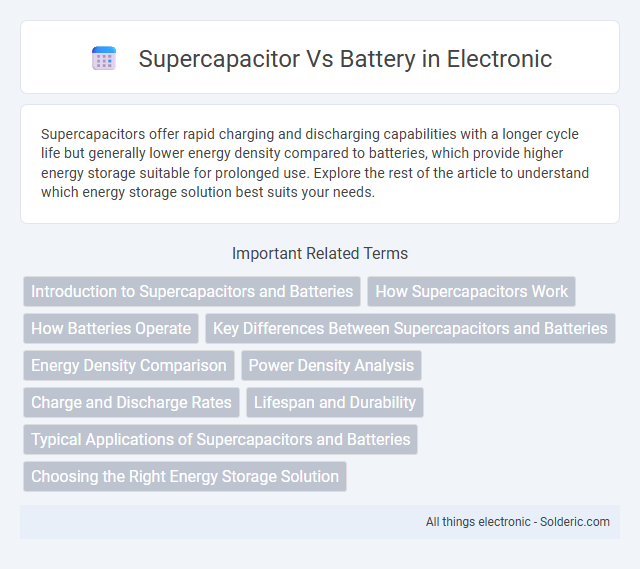Supercapacitors offer rapid charging and discharging capabilities with a longer cycle life but generally lower energy density compared to batteries, which provide higher energy storage suitable for prolonged use. Explore the rest of the article to understand which energy storage solution best suits your needs.
Comparison Table
| Feature | Supercapacitor | Battery |
|---|---|---|
| Energy Density | Low (5-10 Wh/kg) | High (100-250 Wh/kg) |
| Power Density | Very High (10,000 W/kg) | Moderate (100-1,000 W/kg) |
| Charge/Discharge Cycles | Over 1,000,000 cycles | 500-2,000 cycles |
| Charging Time | Seconds to minutes | Minutes to hours |
| Lifespan | 10-20 years | 3-10 years |
| Applications | Power backup, regenerative braking, quick bursts | Long-term energy storage, portable electronics, EVs |
| Temperature Tolerance | -40degC to 65degC | -20degC to 60degC |
| Weight | Lighter for power delivery | Heavier due to chemical storage |
Introduction to Supercapacitors and Batteries
Supercapacitors store energy through electrostatic charge accumulation, offering rapid charge and discharge cycles with high power density but lower energy capacity compared to batteries. Batteries rely on electrochemical reactions within electrodes to provide high energy density for long-term energy storage, though they typically have slower charge rates and shorter cycle life. Understanding the distinct mechanisms and performance characteristics helps you choose the optimal energy storage solution for your application.
How Supercapacitors Work
Supercapacitors store energy through electrostatic charge separation between two electrodes separated by an electrolyte, enabling rapid charge and discharge cycles with high power density. Unlike batteries, which rely on chemical reactions, supercapacitors charge by accumulating ions on the surface of porous carbon electrodes, allowing for greater cycle life and faster energy delivery. Their unique mechanism supports applications requiring quick bursts of energy and frequent recharge capabilities without significant degradation.
How Batteries Operate
Batteries operate through electrochemical reactions that convert stored chemical energy into electrical energy, delivering a steady voltage over time. Inside, electrodes interact with an electrolyte to facilitate the flow of ions, enabling continuous energy discharge until depletion. Understanding this process highlights why batteries provide sustained power for devices requiring long-term energy supply.
Key Differences Between Supercapacitors and Batteries
Supercapacitors store energy through electrostatic charge separation, enabling rapid charge and discharge cycles, while batteries rely on chemical reactions for energy storage, resulting in slower response times but higher energy density. Supercapacitors excel in applications requiring quick bursts of power and long cycle life, whereas batteries are better suited for sustained energy delivery over extended periods. Understanding these key differences helps you choose the appropriate technology based on power needs, lifespan, and energy storage capacity.
Energy Density Comparison
Supercapacitors offer significantly lower energy density compared to batteries, storing around 5-10 Wh/kg versus batteries' 100-250 Wh/kg, making batteries more suitable for long-term energy storage. However, supercapacitors excel in power density, delivering rapid charge and discharge cycles with greater efficiency and longer lifespan. Your choice between the two depends on whether energy storage capacity or quick energy delivery is the priority.
Power Density Analysis
Supercapacitors exhibit significantly higher power density compared to traditional batteries, enabling rapid energy discharge and recharge cycles ideal for applications requiring quick bursts of power. While batteries store more energy per unit volume, their lower power density limits performance in high-demand scenarios where immediate energy delivery is crucial. Your choice between a supercapacitor and a battery should consider the power density requirements of your specific application to optimize efficiency and longevity.
Charge and Discharge Rates
Supercapacitors offer significantly faster charge and discharge rates compared to batteries, enabling rapid energy delivery and quick recharging cycles ideal for applications requiring frequent bursts of power. Batteries, while slower to charge and discharge, provide higher energy density, making them suitable for prolonged energy storage and steady power supply. Your choice depends on whether you prioritize speed and longevity of charge cycles or sustained energy output.
Lifespan and Durability
Supercapacitors exhibit significantly longer lifespans compared to traditional batteries, often exceeding one million charge-discharge cycles without significant capacity loss. Their durability stems from electrostatic charge storage, reducing chemical degradation and enabling stable performance under extreme temperatures and high power demands. Batteries, particularly lithium-ion types, typically endure 500 to 1,000 cycles before noticeable capacity decline, affected by electrochemical wear and temperature sensitivity.
Typical Applications of Supercapacitors and Batteries
Supercapacitors excel in applications requiring rapid charge and discharge cycles, such as regenerative braking systems in electric vehicles, power backup for memory systems, and grid stabilization. Batteries are typical in energy storage for portable electronics, electric vehicles' primary power source, and renewable energy systems due to their high energy density and longer discharge times. Your choice depends on whether you need quick bursts of power or sustained energy delivery.
Choosing the Right Energy Storage Solution
Supercapacitors offer rapid charging and discharging cycles with high power density, making them ideal for applications requiring quick bursts of energy, while batteries provide higher energy density suitable for long-term energy storage and sustained power delivery. Selecting the right energy storage solution depends on specific needs such as charge time, energy capacity, lifecycle, and weight constraints. For electric vehicles and renewable energy systems, combining supercapacitors and batteries can optimize performance by leveraging the strengths of both technologies.
Supercapacitor vs Battery Infographic

 solderic.com
solderic.com